Learning in Lesvos
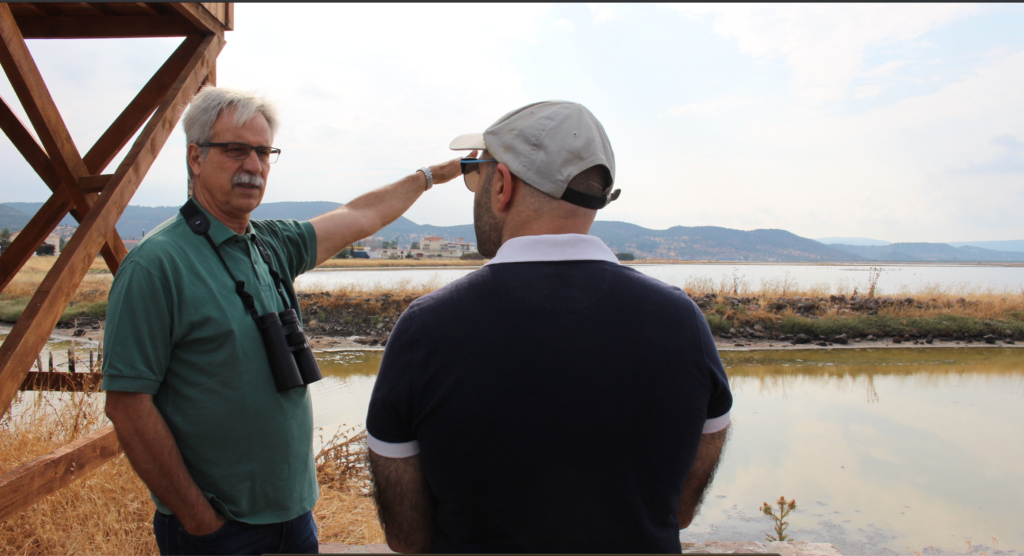
Aristotle’s Lagoon: Naturalist Filios Akriotis informs Ray Raad about the lush bird and sea life in the large inland body of salt water in the middle of Lesvos Island.
From Athens we flew to this large Greek island, a few kilometers off the coast of Turkey. It was part of the ancient Ionian colonies of Greece, where science and philosophy got it’s start with thinkers such as Thales of Miletus. Thales was one of the first to practice the astounding Greek method of formulating natural explanations for phenomena, rather than using gods or mythological forces. This method is the foundation of all science.
We were particularly interested in visiting Lesvos for two reasons: it is the birthplace of the poetess Sappho, and for its lagoon
where Aristotle invented research science. He was the first to systematically collect information, examine, describe, and illustrate the natural world, specifically animals. We had a seminar the first chapter of his Parts of Animals while in Lesvos, and then were taken on a naturalist tour of the lagoon where he did his research.
Dr. Akriotis, above, was featured in a BBC documentary on the lagoon, based on Armand Marie Leroi’s book, The Lagoon: How Aristotle Invented Research Science. Leroi is a professor of evolutionary developmental biology, Imperial College London. He was astonished to find out about Aristotle’s invention of research science when he found History of Animals in a Greek bookshop. He had never been taught about this critical fact in all his biological studies.
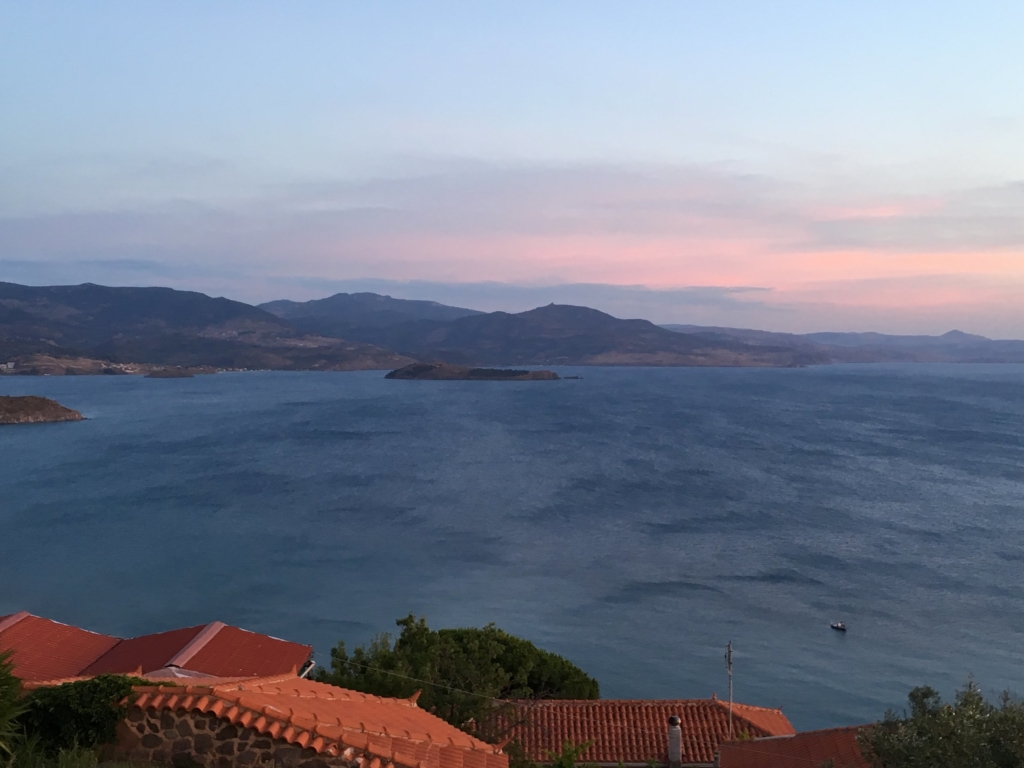
The view of Behram, Turkey, from Molyvos, Lesvos. This is the site of the ancient Greek city of Assos,
Aristotle went to the city of Assos in Anatolia after Plato’s death, welcomed by the tyrant Hermias (in the ancient world, “tyrant” meant a ruler who achieved the position, often by merit, as opposed to “basileus,” king by inheritance). Aristotle married Hermias’ niece, Pythias.
At the urging of his friend, Tyrtamus, whom Aristotle called Theophrastus – “divine speaker” – Aristotle moved to Lesvos island. Theophrastus was a native of the town of Eresos there, and an avid botanist. It seems likely that the botanist’s enthusiasm for the natural world motivated Aristotle to study animals at the lagoon. The cuttlefish was his favorite! Many, many of the species he described still live in the lagoon. The island is renowned for its bird life because the largest number of bird species from Europe and Asia migrate through it. We saw flocks of flamingos, which are relatively new to the island (20 years).
It’s a place that seems ripe for eco-tourism.
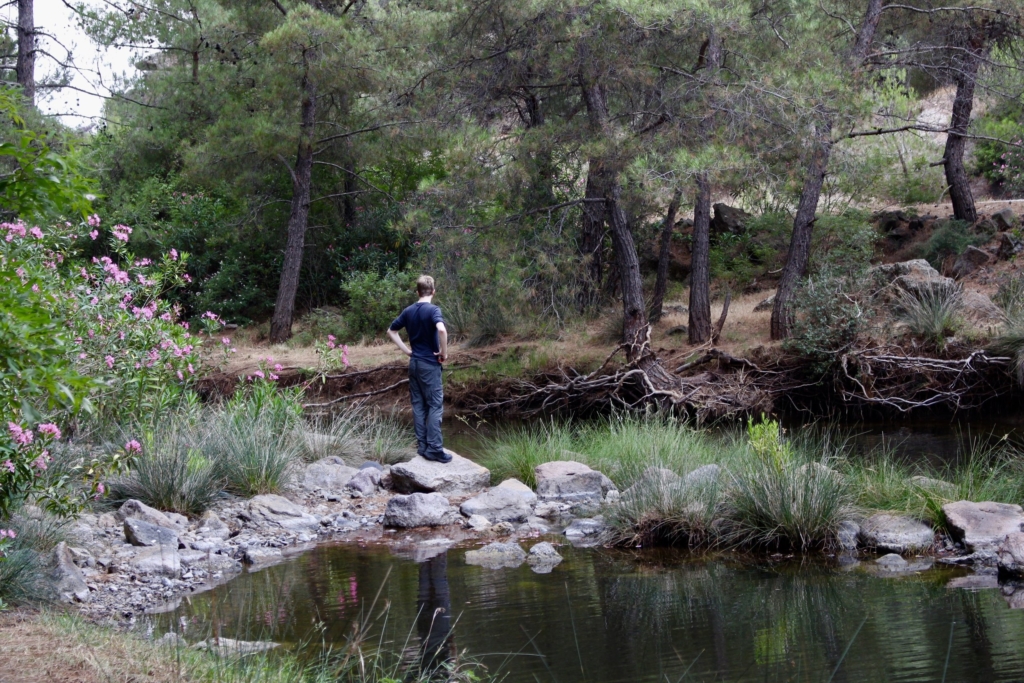
Matt Faherty surrounded by oleander and gazing at turtles along a Lesvos river.
The lyric poetess, Sappho, was our other reason for visiting Lesvos. She was born in the same town as Theophrastus, Eresos, around 621 B.C. and was a prominent figure in her city state. All we have left are fragments of her poetry, but they are so searingly beautiful, it gives her eternal fame. She is one of the first of the lyric poets – you can see how John Keats owes her a debt! (All the following are Mary Barnard translations.)
“And their feet move
Rhythmically, as tender
feet of Cretan girls
danced once around an
altar of love, crushing
a circle in the soft
smooth flowering grass”
——
“At noontime
When the earth is bright with flaming
heat falling straight down
the cricket sets
us a high-pitched
singing in his wings”
—–
“Strange to say
Those whom I treated
well are those who do
me most injury now”
—
Famous in the ancient world, all we have of Sappho are fragments quoted in other ancient authors or put together from papyrus strips that were used on mummies! Yes, her work was published on papyrus and it later got “recycled.” There even seems to be a new finding of her work from Egyptian trash.
“It’s no use
Mother dear, I
can’t finish my weaving
You may blame Aphrodite
soft as she is
she has almost
killed me with
love for that boy.”
—–
“I have had not one word from her
Frankly I wish I were dead.
When she left, she wept
a great deal; she said to
me, ‘This parting must be
endured, Sappho. I go unwillingly.’
I said, ‘Go, and be happy
but remember (you know
well) whom you leave shackled by love
‘If you forget me, think
of our gifts to Aphrodite
and alas the loveliness that we shared
‘All the violet tiaras,
braided rosebuds, dill and
crocus twined around your young neck
‘myrrh poured on your head
and on soft mats girls with
all that they most wished for beside them
‘while no voices chanted
choruses without ours,
no woodlot bloomed in spring
without our song…'”
—–
“As a whirlwind
swoops on an oak
Love shakes my heart”
—–
Eresos is rife with monuments to Sappho, such as the one with Liz Parker in our thumbnail, and as you can see below. She wrote love poetry about men, but also many to women. It is because of her that gay women are called Lesbians, including the one below featuring our traveling lovers, Sable and Noelle.
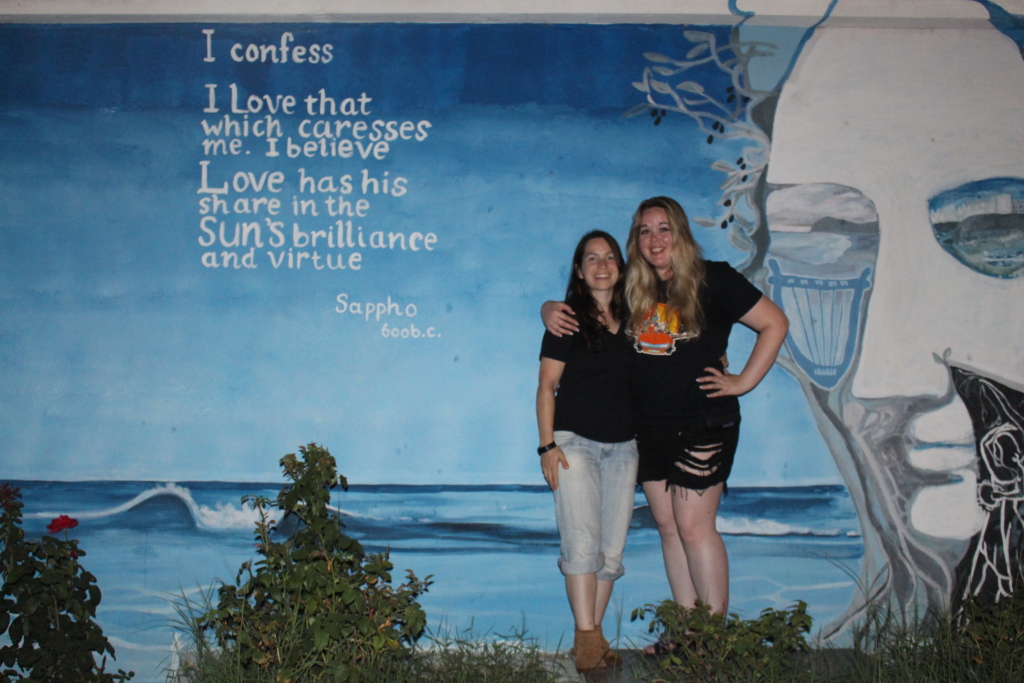
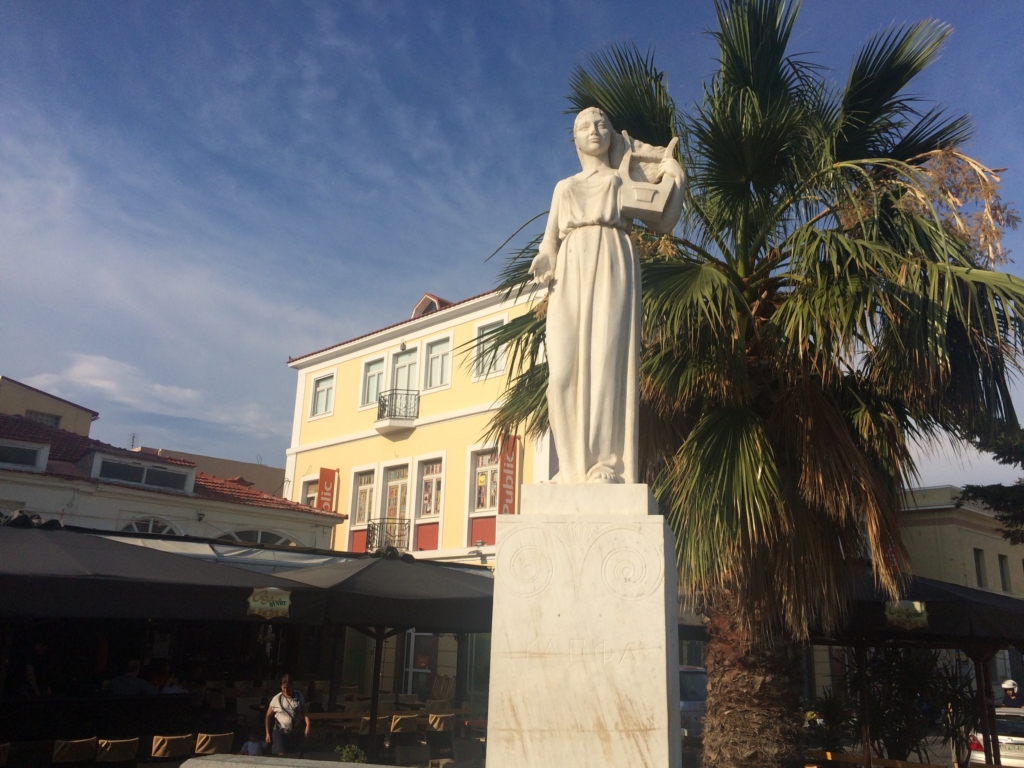
Sappho also had a school for girls, apparently to learn the skills of the Muses.
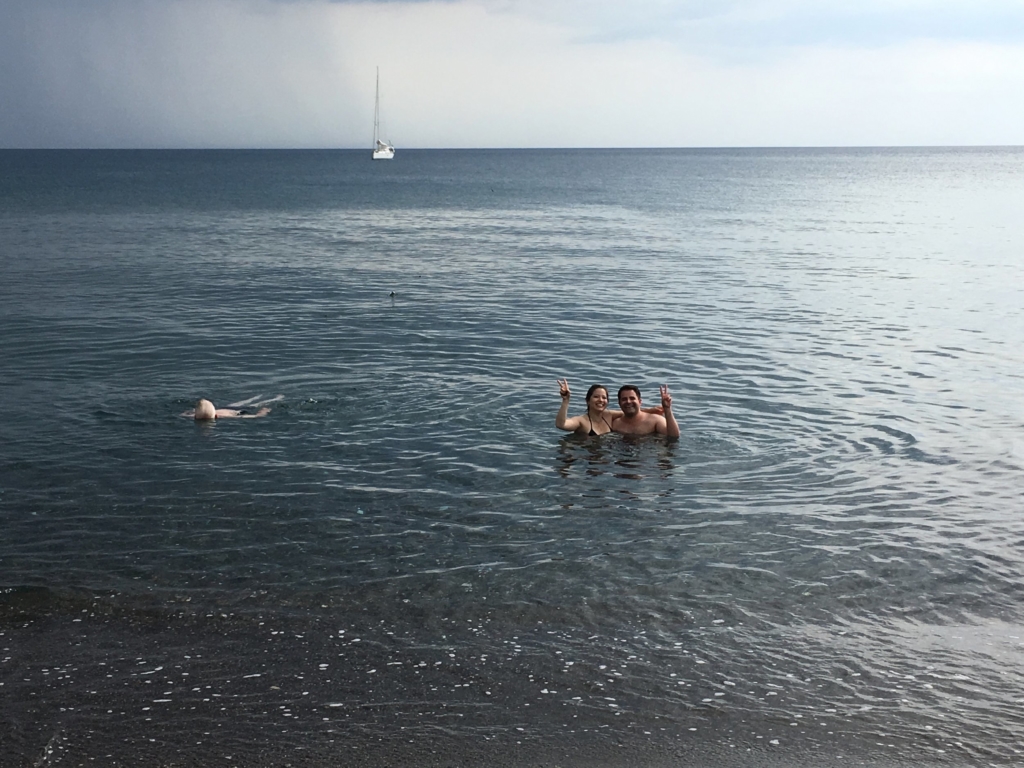
David Kelley on the left, and Liz Parker and Scott Barton at Eresos beach.
Our travelers swam in the Mediterranean for the first time during our trip in Eresos and ranged over the town. Lesvos offered even more natural beauty as we visited a petrified forest and enjoyed lunch on the bay in Mytilini.
Surprisingly, there were almost no tourists – what a shame! And, as on most of our trip, the lodging and food were incredibly inexpensive, especially for what you got.
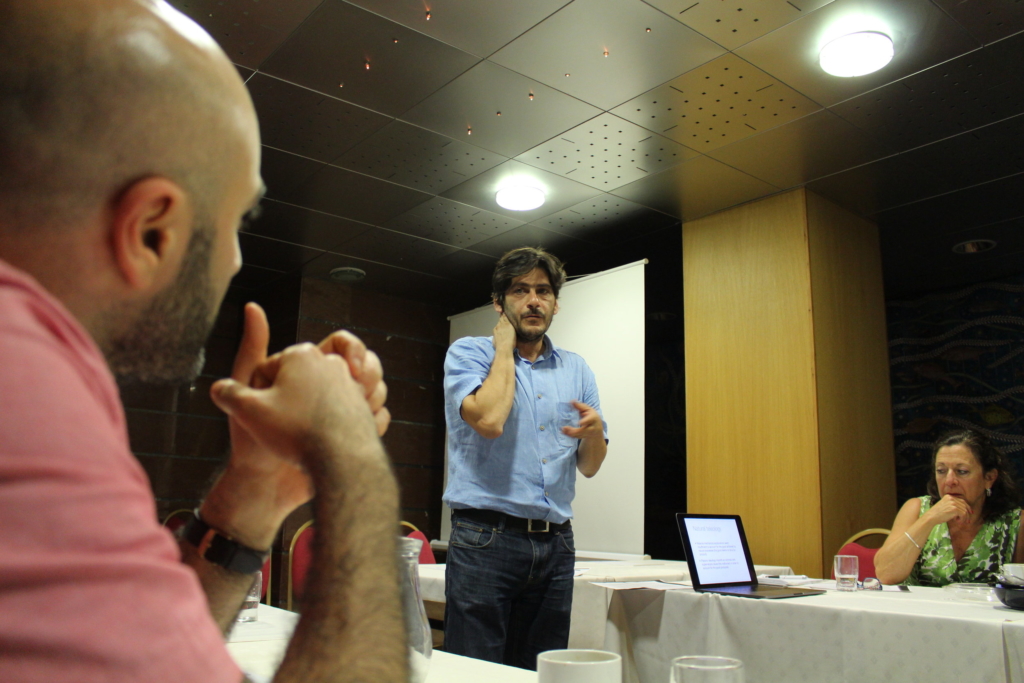
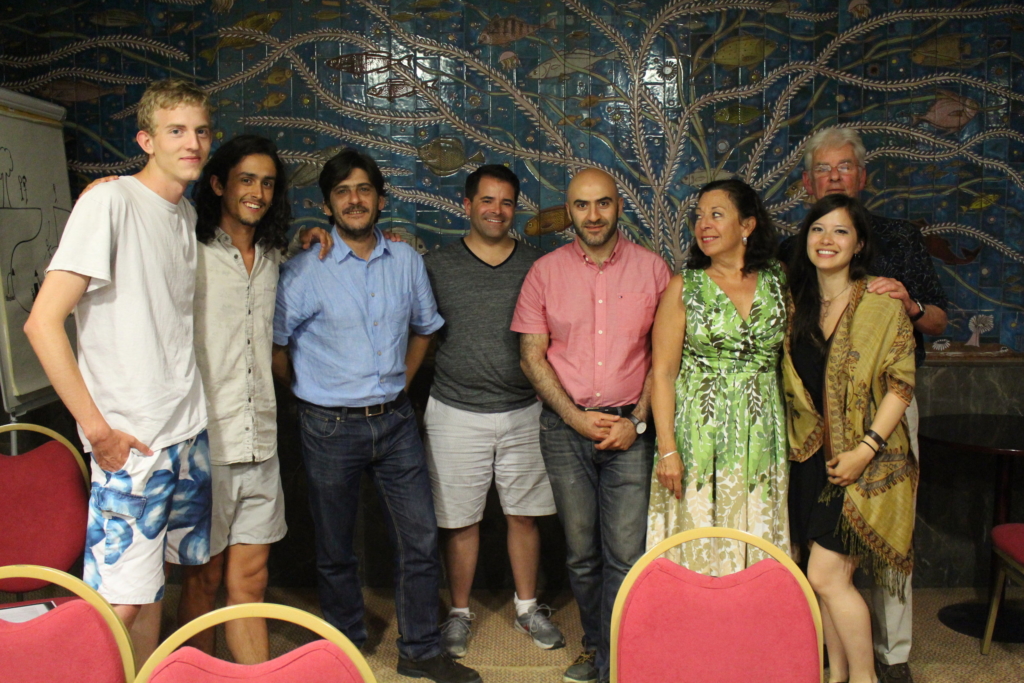
In the top picture, Ray Raad and I listen to professor Stasinos Stavrianeas, professor of philosophy, special interest in biology, at the University of Patras, Greece. Bottom are most of the people at the lecture, from left, Bill Rein, Ian Mihura, Stasos, Scott Barton, Ray Raad, myself, David Kelley, and Liz Parker.
Dr. Stavrianeas spoke to us about the depth and impact of Aristotle’s work in biology, giving us a fuller context of its meaning and importance: Aristotle doesn’t merely catalog the animals he studies, he gives a philosophical explanation for his approach and method of study, and he formulates the basic principles of the philosophy of biology. Dr. Stavrianeas shared one of his favorite quotes from Parts of Animals, which is often called the “Invitation to Biology”:
“Surely it would be unreasonable, even absurd, for us to enjoy studying likenesses of animals – on the ground that we are at the same time studying the art, such as painting or sculpture, that made them – while not prizing even more the study of things constituted by nature, at least when we can behold their causes.
“For this reason we should not be childishly disgusted at the examination for the less valuable animals. For in all natural things there is something marvellous. Even as Heraclitus is said to have spoken to those strangers who wished to meet him but stopped as they were approaching when they saw him warming himself by the oven – he bade them enter without fear, ‘for there are gods here too’ – so too one should approach research about each of the animals without disgust, since in every one there is something natural and good.” Book 1, Chapter 5, lines 17-23, translated by University of Pittsburgh Professor of History and Philosophy of Science, James Lennox.
We were delighted to learn that Dr. Stavrianeas is good friends with James Lennox!
Next time I’ll describe our tour of the Peloponnese, including the Tomb of Agamemnon and ancient Olympia.
But before I go I want to give a huge “Thank You” to our traveler, psychiatrist Ray Raad. After watching the documentary on the lagoon, he read the book, then contacted Dr. Leroi who got us in touch with Drs. Kokkoris, Akriotis, and Stavrianeas! Ray organized our visits and field trips with them. And thank you to all of them, including Dr. Leroi, for their generous gifts of time and knowledge.


There are no comments